
Space tourism has been a dream of humanity for millennia. While in orbit or in free fall near Earth, you can float inside a spacecraft and view the planet from a unique vantage point. Though commercial space tourism has arrived, it is only for a privileged few. However, with recent innovations, it may be accessible to many soon. While very few can go to space, anyone with good eyes can see it for free. They can also do amateur astronomy, visit spaceflight sites, or learn about it.
Regions
[edit]Outer space or simply space is the great empty above us. The most common definition is that space begins just 100 km (62 mi) above Earth's sea level, a boundary known as the Kármán line. Above that height, tourists need space technology to get there and to survive, as even high-altitude aviation technology won't suffice. The trick with spaceflight is that it's not about going high... it's about going fast. In low Earth orbit, that means speeds around 7.8 km/s (28,000 km/h or 17,000 mph), enough to circle the entire globe in about 90 minutes. Space is characterized by near-vacuum, with the atmosphere dwindling to a few atoms per cubic meter in interplanetary space. As the spacecraft moves along gravity in freefall, astronauts can feel the sensation of weightlessness, or microgravity.
A further paradox of space is that it's mapped and managed in great detail, more than many places on Earth. Bygone explorers setting out into new continents or seas had little idea what lay before them or where their journey might lead, and they might be out of contact with home for years. Those heading into space have planned precise trajectories, computed to the split-second. Throughout the day, they coordinate with mission control, and in their free time, they can have audio and video calls with their families at the speed of light.
These are the destinations that most of us would ever dare dream of experiencing. Tourists may go whipping around at thousands of meters per second. Adjusting the spacecraft's speed using propellant can change its orbit, going higher or lower. The low Earth orbit region is a popular place for space stations since a relatively small amount of fuel is needed to get there. That said, every single human has been inside Earth's gravitational influence, as the furthest that anyone has traveled is to the dark side of the Moon.
Technically, the distinction between space and the upper atmosphere is arbitrary. Since the atmosphere becomes less dense as a spacecraft goes up, drag in "space" is a real issue. In fact, the International Space Station needs to get boosted once in a while to prevent it from falling back into the atmosphere. The 100-km altitude is chosen because this is the hard limit on any kind of air travel, but also because it's a nice round number. So don't worry if a space tourism company carries you just shy of that distance – it is still the experience of a lifetime!

| Low Earth orbit Between 100 km (62 mi) (Kármán line) and 2,000 km (1,200 mi), this is the most popular destination of all spaceflight, sub-orbital or on the International Space Station. The region presents the least risk and is the easiest to go to. |
| Medium Earth orbit Between 2,000 km (1,200 mi) and 35,786 km (22,236 mi), there is an intense level of radiation from the Van Allen belts. Along with poor space infrastructure, this place is not a popular destination. |
| Geosynchronous orbit About 35,786 km (22,236 mi) in altitude, this is the place where many satellites orbit. This is because they would stay at a spot in the sky relative to the Earth. There, travelers would always see one side of the Earth. |
| High Earth orbit Above 35,786 km (22,236 mi) is past the Van Allen belts, therefore a space station can stay here for extended periods. However, this is not a practical place to tour, as its experience is the same as that of lower orbits with higher costs. |
| Highly elliptical orbit A special type of orbit in which the lowest point (perigee) and highest point in orbit (apogee) differ significantly. This can take advantage of both low and high-orbit vantage points, while still dodging the deadly radiation belts. |
| Moon The only natural satellite of Earth, it has inspired humans to go explore since since prehistoric times. Dominated by craters and "seas", they are a popular planned destination for many tourists. However, as of 2022, only 12 people have walked on it. |
| Lagrange points These points are where the gravitational forces of the Earth and the Sun cancel out, labeled L1 to L5. They also host paths that don't necessarily go around the planet, called halo orbits. |
Other destinations
[edit]
Besides these natural destinations mentioned above and staying inside a spacecraft, there are two space stations in operation as of May 2023. These are:
- International Space Station, Earth, perigee: 413 km, apogee: 420 km, inclination: 51.63° (See "Spot the station" for directions). 6AM to 9:30PM UTC. The most well-known space station of all, also the largest and most long-lasting, jointly-operated by the United States, Russia, the European Union, Canada and Japan. It is a popular destination for space tourists, primarily because Roscosmos agrees to launch them into the station. Contains many modules and facilities, a hub for science and engineering advancement. The first module was launched in 1998, though the plans for it has been made decades prior, named space station Freedom. You can go to there using Crew Dragon or Soyuz capsule. US$35000 per day per astronaut.
- Tiangong (Chinese: 天宫), Earth, perigee: 389.5 km, apogee: 395 km, inclination: 41.58° (See "Observation of Tiangong" for directions). A true second space station, owned by China. Smaller than the ISS, the first phase of Tiangong was completed in 2022, with three modules with capacity for 6 people and a regular crew of 3. Traveling there would require riding on the Shenzhou spacecraft. To date, all visitors have been Chinese, but the government has announced that it will grant access to foreigners for scientific collaborations, though American and British citizens are not eligible. Price not public.
Understand
[edit]History
[edit]| “ | Glory to those who look forward! Glory to those who go forward! Our path starts from the present— To the bright future! Our path starts from the present— To the coming years! |
” |
—Sergei Grebennikov, Nikolai Dobronravov, Glory to the Ones who Look Forward | ||

Outer space was not well understood for millennia. People believed that the atmosphere extended upwards indefinitely, and if people could rise high enough on balloons or flying contraptions, they would eventually reach the moon and the stars. Only in the 17th century, did advances in math, physics, and technology begin to reshape our understanding. Telescopes show what lay beyond our own world, such as the moons of Jupiter. Through the theory of gravity and Newtonian physics, we discovered that outer space is a vacuum and how stars, planets, and moons orbit each other.
In the 20th century, Russian teacher Konstantin Tsiolkovsky published landmark papers, and American scientist Robert Goddard experimented with rocket designs. While early 20th-century rocketry pioneers had their eyes on the stars, rockets had not yet escaped their military origins. By 1944 Germany had built the V-2, the first ballistic missile, to rain down on targets at speeds that made it invulnerable to anti-aircraft guns and fighters. The development of long-range ICBMs led to the Space Race during the Cold War – both the United States and the Soviet Union were now competing for the "firsts" in spaceflight.
Under the leadership of engineer Sergei Korolev, the Soviet Union got this first on 4 October 1957 when Sputnik 1 orbited the Earth for 21 days. On 3 November 1957, the Soviet Union succeeded in putting Laika the dog into space aboard Sputnik 2, making her the first animal to orbit the Earth. Yuri Gagarin then became the first human to be successfully launched into space onboard Vostok 1 on 12 April 1961. Then, in 1967, reckless development resulted in fatal disasters for both programs: A fire killed all three American astronauts on board during a launch simulation of Apollo 1, and a crash killed the Soviet cosmonaut on board Soyuz 1.
The United States program then picked up its pace and peaked when Apollo 11 landed on the Moon on 20 July 1969. When Neil Armstrong and Buzz Aldrin walked on the lunar surface, it was watched live by 723 million people, more than one-fifth the population of Earth. Six more missions followed through December 1972. However, the wild dreams of the 1960s and 70s died as the public realized the cheap and easy space tourism they'd been promised wasn't forthcoming.
Satellites were starting to become accessible in the 1980s. In 1990, the Hubble Space Telescope was launched into orbit, marking great milestones in space observation. The Space Shuttle debuted in 1981, becoming the first working spaceplane. At the same time, the Russians were developing the Mir space station, and the Americans were planning out space station Freedom. Space station Freedom would then be converted to become the International Space Station. Returning to spaceflight's private sector, Dennis Tito became the first pay-to-fly space tourist in April 2001. Others soon followed suit.
China became the third country to put a person into orbit with the launch of Shenzhou 5 in October 2003. Since then, the country's space program has been expanding its presence. India in the 21st century also expanded their space exploration scope drastically. In December 2015, SpaceX's reusable Falcon 9 rocket landed on its landing site, aiming to reduce launch cost drastically. Since then, Virgin Galactic and Blue Origin sent a couple of passengers on short journeys to the edge of space in July 2021. While space remains a destination for just a few people, it's definitely more accessible as these spaceflight technologies get refined.
People
[edit]
Most of the people to visit space so far have been astronauts or cosmonauts — professionals who are paid to train for and perform spaceflights. The distinction between the names is largely one of respect. The term "cosmonaut" is reserved for Russian astronauts. Chinese astronauts are also often called "taikonauts" after the Chinese word for "space" (太空 tàikōng). The names are not based on nationality. For example, the first East German in space, Sigmund Jähn, is a "cosmonaut" because he rides on the Soviet Soyuz. The first West German in space, Ulf Merbold, is called an "astronaut" because he rides on the Space Shuttle.
The remaining few are called space tourists, though NASA and Roscosmos prefer the term spaceflight participant. A more careful distinction can be drawn between those from nations that don't have an astronaut program and self-funded tourists who paid their way into space.
Climate
[edit]Since there is no atmosphere in space, spacecraft must create one for the astronauts to survive. Therefore, the atmosphere composition can vary widely. In the past, spacecraft used pure oxygen for convenient atmosphere storage, but nowadays it matches much more like Earth. Onboard the International Space Station, the temperature can range from 18 to 26 °C (64 to 79 °F), with humidity at around 60%. Therefore, it is wise to wear a light jacket to keep your body comfortable. In a spacesuit, the climate can be controlled more easily. In that case, comfortable and tight inner clothes would be the best fit, as the suit is very stiff.
In practice, outer space doesn't have a "temperature", since there is very little matter around. These temperatures more often refer to the surface temperature, which can be misleading as an object in different orientations would receive heat from the Sun differently. Without sunlight, the temperature is around −270.5 °C (−454.9 °F), 2.7 degrees above absolute zero!
Units of measure
[edit]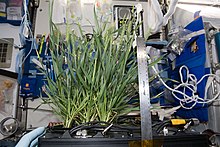
Most activities in space use the metric system because almost all countries adopt the standard. However, in the United States, many parts are manufactured in the imperial system, resulting in a mess of conversions. The most embarrassing case of these mishaps is the deorbit of the Mars Climate Orbiter in 1999, as the spacecraft interpreted the data as in metric units, even though it is in imperial units. Other countries are not immune to this either, as many space components use the imperial system, especially with diameter measures. As for a space tourist, it should not matter too much as most things are metric already.
Politics
[edit]The concept of politics in space is given a very futuristic name: astropolitics. The most well-known document about this is the Outer Space Treaty. In short, it recommends countries consider that space "shall be the province of all mankind". This includes fostering science development, no claim of sovereignty on planets and moons, and no mass destruction weapons in space.
A prime example of how politics affect space operations is the Mir space station. After the collapse of the Soviet Union, the space station allowed commercialization to get enough operating money. As tension between the United States and Russia is rising again due to the Russian invasion of Ukraine, space may become more militarized. For space tourists going to the International Space Station, politics should be separated from their spaceflight to prevent conflicts. The United States is the only country in the world with a space force, a branch of the military dedicated to warfare in space.
Events
[edit]- See also: Solar eclipse
Talk
[edit]- See also: Russian phrasebook, Mandarin phrasebook
Like polar bases and other multinational ventures, space travel uses the languages of the craft's operators. English is the working language of space, used for many space operations and international coordination on the ground. Russian is the secondary language, as Soyuz missions use exclusively Russian until reaching the International Space Station. Sometimes, signs and labels on the station are bilingual. Naturally, Mandarin is spoken on Chinese missions to space.
English is generally the working language in the International Space Station, though usually, crews are fluent in both English and Russian. Space tourists on the International Space Station must learn enough English. They also need to know basic Russian (250 hours of language training during 6 months of study, or about 2 hours per day).
There is a lot more jargon in spaceflight than in many other places, partly because most people are technical-minded. Here are some of the basic terms that tourists and space-interested people should be familiar with:
|
|
Get in
[edit]| “ | Given ships or sails adapted to the breezes of heaven, there will be those who will not shrink from even that vast expanse. | ” |
—Johannes Kepler | ||
Entry requirements
[edit]
Only the United States, Russia, and China can send people into space as of date. Nine other countries and one organization named the European Space Agency has launched objects to space using their domestic launch vehicles.
The other independent countries that have launched satellites into space and have active space programs are Japan, India, Israel, Iran, New Zealand, North Korea, South Korea, and Ukraine. However, Ukraine has never put its own satellites into orbit. The European Space Agency includes Austria, Belgium, Denmark, Finland, France, Germany, Greece, Ireland, Italy, Luxembourg, the Netherlands, Norway, Portugal, Spain, Sweden, Switzerland and the United Kingdom.
As of February 2022, nine countries are actively working on placing satellites in orbit: Brazil, Australia, Indonesia, Taiwan, Kazakhstan, South Africa, Argentina, Pakistan, and Turkey. Besides those, some countries had plans to be space-faring but are now abandoned: Canada, Egypt, and Iraq. Citizens of other countries who do not have space capabilities can fly on spacecraft built by these countries, though be wary of sanctions before booking a flight.
In the United States, space tourists must be able to withstand high acceleration, deceleration, vibration, and microgravity during spaceflight. They also must be trained to deal with emergency situations, such as smoke, fire, loss of cabin pressure, and emergency exit. The training course can last from a few days in suborbital flights to a few months in orbital flights.
Training would be much less stringent for those boarding a reduced-gravity aircraft. Almost all age groups are eligible to fly on one of these aircraft. However, those with medical conditions should consult the provider and doctors before. The tourist may also need to submit medical certificates and other measurements in some countries.
By reduced-gravity aircraft
[edit]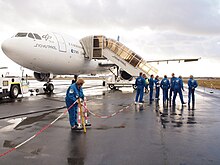
The weightlessness experienced in orbit can be created by a parabolic aircraft flight, which alternates low g-forces for about 30 seconds at the top of its arcs with high g-forces at the bottom. These parabolic flights are notoriously nausea-inducing, leading to the nickname Vomit Comet, but commercial operators claim that their shorter flights (15 parabolas) are considerably gentler than research and training flights which involve 40-80. They are also much less costly than risky than other options, though the price can be steep for some people.
- 1 Incredible Adventures Florida, Kennedy Space Center, Space Commerce Way, Merritt Island, Florida, United States (go east through Florida State Road 528 and turn left at Florida State Road 3), ☏ +1 941 346-2603, toll-free: +1 800 644-7382, info@incredible-adventures.com. The only provider for individual reduced-gravity flights, with a general plan from Martian gravity (1/3 Earth gravity) to lunar gravity (1/6 Earth gravity) and finally to zero-g. The small Rockwell Commander 700 plane will make 10-12 maneuvers, with each maneuver lasting 10 seconds. $4500 per adult, children under 18 years old are not allowed.
- Zero Gravity Corporation (ZERO-G), ☏ +1 703 894-2188, toll-free: +1 888 664-7284, fax: +1 702 947-6343, info@gozerog.com. Offers reduced-gravity flights on a modified Boeing 727 named "G-FORCE ONE" with a large compartment suitable for weightless tumbling. 15 parabolas will be flown, with several brief simulations of micro-gravity, lunar gravity (1/6 Earth), and Martian gravity (1/3 Earth). There are about 8 minutes of microgravity. See the listing for booking flights. US$5,400 for 1 seat, US$55,000 for 12 seats, US$165,000 for private flight.
By suborbital spacecraft
[edit]
A suborbital flight can fly high into space, but not fast enough to achieve orbit. This means that the spacecraft is in space in just a few minutes, so be sure to plan everything beforehand. Price for these spaceflights are pretty steep by conventional standards, but it is certainly cheaper than an orbital spaceflight. As of 2022, there are two operators offering sub-orbital flight, consisting of Virgin Galactic's SpaceShipTwo spaceplane and Blue Origin's New Shepard rocket. There are many more companies that plan to offer such services, but they won't go online for many years.
Spaceports
[edit]- 2 Gateway to Space Terminal, County Road A021, Truth or Consequences, New Mexico (from County Route A13, turn left to County Route A39, and turn left again at the roundabout). Constructed by Virgin Galactic, the place is the hangar for the SpaceShipTwo spaceplane. Riding on a mother aircraft, SpaceShipTwo detach mid-air and boost to about 80 km, reaching Mach 3 speed. While total flight time is 2 hours, the feeling of weightlessness will only last for about 6 minutes. Flights will be taken at Spaceport America with a portfolio of four successful flights.
- 3 Launch Site One (Corn Ranch), Texas Highway 54, Van Horn, Texas (turn left near the Figure 2 Ranch Airport and wildlife management areas). Owned by Blue Origin, this facility is used to launch the suborbital New Shepard rocket. There, in the ten-minute flight, the rocket would go up, separate the capsule, and the weightless adventures begin. Then, the rocket stage lands vertically, the capsule deploy its parachutes and land with a loud "thump". New Shepard has been crewed three times, but it has been tested countless times in the past.
Spacecraft
[edit]- New Shepard. Owned by Blue Origin and launches from the company's Launch Site One. The spacecraft is a capsule attached to a rocket stage, and deploy near to space. The rocket stage can then land back on Earth, with a prospect for reusability to lower cost. Maximum altitude: 100 km (62 mi). Has constructed 4 crafts and test launched more than a dozen times without failure. Has launched the company's CEO, Jeff Bezos, to space, and launched NASA experiments for weightlessness. Price not public.
- SpaceShipTwo. Owned by Virgin Galactic and launches from the Gateway to Space terminal. The craft is carried by a double-deck plane, once reaching to an altitude, it detaches and propelled by a solid rocket motor. Maximum altitude: 85 km (53 mi). Successor to SpaceShipOne that won the Ansari X Prize. 2 spaceplane has been built, called VSS Enterprise and VSS Unity, the former has been involved in a deadly crash. VSS Unity has launched 5 times, including one with the company's CEO, Richard Branson. US$450,000 per seat, reservations US$150,000.
By orbital spacecraft
[edit]
This is the real deal. Some people will not going to accept that a tourist were "in space" until they've gone into orbit. The minimum practical height for this is 350 km; otherwise, atmospheric drag will force the spacecraft down. The price tag for a trip to this region starts at around an eye-popping US$40 million. So, it is wise to wait and invest in these companies, for them to boost the development of cheap and convenient space access. The most promising of all is Starship rocket in development, carrying 100 crews with "less than $1 million" cost per launch. Although, in practice, the price tag would still be really high for ordinary citizens.
Spaceports
[edit]- 4 Baikonur Cosmodrome (Kazakh: Байқоңыр ғарыш айлағы, Russian: Космодром Байконур), Kyzyl-Orda region, Kazakhstan, ☏ +7 (495) 664-31-29, go@baikonurtour.ru. The launch place of many early space tourist, Baikonur Cosmodrome was the only place where you can hitch a ride to the International Space Station. The spaceport has two launch pads for human spaceflight: Gagarin's Start (Site 1) and Site 31/6. They are used by the Soyuz rocket and capsule.
- 5 , Cape Canaveral, Florida, United States. This is the only crewed launch site that is operated by a space force. The launch site is integral to the early days of American spaceflight, which launches Mercury, Gemini, and Apollo test missions. It has an active launch pad for crewed spaceflight named SLC-41, licensed for the Starliner spacecraft.
- 6 Jiuquan Satellite Launch Center (Chinese: 酒泉卫星发射中心), Ejin, Alxa, Inner Mongolia, China. This spaceport is prehaps the most secretive on the list, due to obvious national security reasons. It is, however, perhaps the only place for Chinese space tourists after the soft-ban imposed by NASA. The only active crewed launch pad is SLS-1 in Launch Area 4, used by the Shenzhou spacecraft.
- 7 Kennedy Space Center, Space Commerce Way, Merritt Island, Florida, United States, ☏ +1 855 433-4210. This is the most famous American spaceport, due to it has a rich history of launching most Saturn V and Space Shuttles. Nowadays, the space center has one active crewed launch pads (like terminals in an airport) name 39A. The launch pad is licensed to SpaceX for its Crew Dragon capsule.
Spacecraft
[edit]- Crew Dragon. The SpaceX craft is a successor to the highly successful Dragon 1 cargo capsule. With spacious cabin (9.3 cubic metres (330 cu ft)), ergonomic seats, and modern control panel, it is truly a first-class experience for space tourists. The spacecraft has launched 8 successful missions, 1 uncrewed, 5 for NASA, and 2 all-tourists missions. SpaceX has also made attempts to put the cost of space travel low, by reusing the capsules 3 times, and launch on the reusable Falcon 9 rocket. US$55 million.
- Shenzhou (Chinese: 神舟). The Chinese-developed spacecraft is somewhat similar to the Soyuz, but a bit more comfortable with 14 cubic metres (490 cu ft) of space divided to 2 modules. It is designed to go to the Tiangong space station, and has launched 13 times, 5 crewed. Little is known about the spacecraft interior and amenities inside. Price not public.
- Soyuz (Russian: Союз). It is the longest used space capsule design in the world, with many upgrades since the 1967. The Soyuz family has made more than 140 flights, though the latest iteration named Soyuz MS made 21 flights, 1 of which has been aborted. It is the tightest spacecraft with only 10.5 cubic metres (370 cu ft) of space in two modules, and the price is not cheap. However, you do get the extreme reliability and rigorous training while operating the capsule. US$21.3 – 90.3 million.
- Starliner. Though somewhat late to the International Space Station race, it is a solid alternative to the heavily-booked SpaceX's Crew Dragon. Starliner is made by the Boeing Company, the one that made airplanes. It has launched successfully once, uncrewed, to the station via the Atlas V rocket. Starliner has a 11 cubic metres (390 cu ft) volume, seven crew capacity, and has relatively comfortable seats. The capsule may be reusable, though no reused Starliner has ever flown to orbit yet. US$80 million.
By interplanetary spacecraft
[edit]Leaving the endless loop around Earth to journey elsewhere in the Solar System and beyond. Nobody has gone that far since the Apollo 17 flew the last lunar mission in 1972, nearly fifty years ago. The Artemis program plans to send a crewed spacecraft to Moon orbit in 2024; actually landing people on the Moon is not expected until the late-2020s. There are no other government-backed projects to return people to the Moon or to reach Mars, though work continues on the massive challenges such as self-sufficient habitats. Commercial or private proposals are wildly speculative.
Space tourism companies
[edit]Unlike airplanes, you can't just pick up the phone, call the launch sites and arrange launch schedules. You will need help from space tourism companies.
- 1 Space Adventures, 8245 Boone Blvd, Suite 570, Vienna, Virginia, United States, ☏ +1 (703) 524-7172, info@spaceadventures.com.
- 2 Axiom Space, 1290 Hercules Avenue, Houston, Texas, United States, ☏ +1 (346) 293-7045.
Get around
[edit]Most space travelers remain inside their spacecraft and use its propulsion systems to get around. As orbital mechanics is extremely unintuitive and fuel for maneuvering is quite limited, these tasks are best left to a qualified pilot and computers.
By yourself
[edit]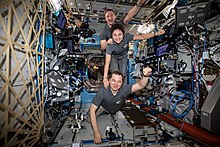
Inside your craft, it's very easy to move around using your hands and feet. Craft are designed with ample handholds and footholds for moving yourself around as well as anchoring yourself in place while you're working. You're unlikely to get stuck out of reach of one, as momentum, air currents, and other minuscule movements of your craft make it difficult to remain perfectly stationary. However, tourists could be stuck for many minutes, possibly even hours of that's happens.
Whenever a person reach out for a surface, the rest of your body will move away just as much, preventing them from reaching anything. "Swimming" through the air doesn't work either, since unlike water, air offers very little mass to push against. Your best bet, other than asking for help, is to throw something reasonably heavy, such as your clothes, which will propel the person slowly in the opposite direction.
Moving things in a weightless environment is not intuitive, and doing it right takes practice and training. Sure, you can push or pull a massive object just as easily as a tiny one, but what's really happening is that you and the object are moving towards or away from each other. If you try to use a screwdriver, for example, what will actually happen is that the screw and the spacecraft it's attached to will rotate a tiny amount, while your comparatively small body rotates the rest of the way in the opposite direction — not at all what you were trying to accomplish!
What you need to do is anchor yourself to the spacecraft so you can turn the screwdriver and screw without turning the craft. On Earth, gravity holds you to the ground with the force of your whole bodyweight, but in space, you have to use muscle power to provide that force. (Imagine holding a block of wood in your hand, and trying to put a screw in it. It's much harder than trying to put a screw in a wall.) Astronauts practice in neutral buoyancy pools, large pools where objects underwater are balanced to neither float nor sink. Many tasks in space, particularly during EVAs, are performed very slowly and methodically.
By orbital spacecraft
[edit]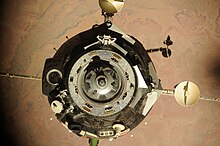
Locating yourself in space is crucial. Unlike addresses on Earth, locations in space are often refer to its orbit, i.e. path around a parent body. This is because you're constantly moving in space, interacting with planets and moons along the trajectories. Some characteristics of an orbit includes its relative position, inclination, apogee/perigee (highest/lowest point in orbit), etc. The usual units used are kilometers, astronomical unit (distance from the Earth to the Sun), and degrees respectively. In practice, that would mean using an array of telescopes to measure these data accurately. Predicting the future location of an object can be done very accurately, as engineers rely on that to push the spacecraft to the correct destination.
By suits
[edit]Occasionally, space travelers must do extra-vehicular activity (EVA), where they exit their craft to access scientific experiments or perform repairs. For this, you need a very rugged spacesuit, which provides breathable air and protects you from the vacuum of space, harmful radiation, and extremes of temperature (from near absolute zero in the shade to absolutely roasting in the ferocious sunlight).
While a tourist can zoom around to their heart's content inside the spacecraft, outside of it, the person can easily become stranded with no propulsion left, potentially doomed the tourist a short life until air supply runs out in a few hours. Maneuvering units with small thrusters have been used a handful of times (most recently in 1990), but the safety risk is considered too great, and the scant advantages are certainly not worth the potential trouble. Today an emergency-use one is worn on all EVAs but has never yet been used outside of tests. EVAs are always conducted tethered, and often not just tethered but firmly attached to the Canadarm2 grappling arm so your crewmates can move you around.
See
[edit]- See also: Spaceflight sites, Astronomy
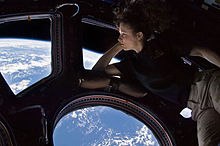
Sightseeing in space is a must – after all, isn't it attractive? There, the Earth's boundaries are visible, making quite a few space visitors experiencing a shift in their awareness, dubbed the "overview effect". There, they become much more aware of how fragile and isolated life on Earth is compared to the vastness of the universe. In suborbital flight though, you needs to plan out everything in advance, or you would miss everything! Also for that reason, you should forget about taking pictures from a phone, as the spacecraft would likely have an array of cameras.
Earth
[edit]Earth is a remarkable sight, with its whorls of weather systems, blue oceans, "phases" as you pass from day to its night side, and glowing nighttime cities. If you orbit the moon, as you pass around its far side you lose radio contact as well as sight of the planet, and suddenly feel very much alone in the universe. Then you come around the corner and with relief see earthrise. You don't see this from the lunar surface without moving, as the Earth holds a nearly fixed position in the lunar sky.
- Northern and Southern Lights. Formed at the edge of space, at an altitude of a few hundred kilometers, they can seen far below you flickering across the Earth's night surface.
- Weather patterns. Unlike other planets, Earth is substantially yet partially covered by clouds. In space, the clouds don't look like moving at all, but it's enough for you to have a new cloud pattern after going around an orbit. Hurricanes and typhoons can also be seen from space, though you should bring with you a telescope to see them in all of their glory.
Astronomical objects
[edit]By 25 km (16 mi) altitude (well short of reaching space), all blue has drained from the sky, you're far above the weather systems, and you can see the curvature of Earth's surface. The stars become fixed points of light instead of twinkling: you'll see a rich field of them as you orbit the night side of Earth, but on the day side the glare of "earthshine" blanks out almost everything else. In low Earth orbit, sunrise and sunset flash by every 45 min; there's a brief red glow, but not the prolonged colors you see from the surface.
- Moon. In space, the Moon don't look nearly as different as on Earth. However, seeing the Moon through there is far different than seeing it in picture, as it will give you a sense of wonder and awe. Prepare to take a telescope to view the Moon in all of its glory, as there is no atmospheric distortion to worry about.
- Stars. They can be seen very clearly without the Earth's atmosphere obstructing. Have a nice view of the Milky Way, or dream about humans going to Proxima Centauri, our closest neighbor. Make sure to equip with long-exposure cameras and software to get the nicest pictures.
- National Gem and Mineral collection (part of the Smithsonian in Washington, D.C.). This has a fine collection of meteorites, quite likely the world's best.
Do
[edit]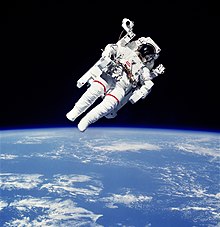
Once you're there, there are a lot of activities to do. You can do extravehicular activities (EVA), better known as space-walking, means exiting the spacecraft to float around in space. It's only realistic in orbit and beyond, as a suborbital flight is too brief. Space Adventures offer EVA, but there have been no takers yet: it costs US$20 million extra, requires an extra month of training, and has additional fitness qualifications. You can do science as well, but be sure plan this with the organizers in advance, and assume it must involve zero extra weight. At the very least, you can be the subject of medical observations. You might not need to bring a camera if the spaceship's CCTV and external imaging is comprehensive.
As a space tourist, unbounded by tight schedules, you can do a lot of fun experiments that no one has ever done before. Yusaku Maezawa, for example, is the first to play various sports inside the space station, such as frisbee and golf. Speaking of golf, it is also played on the Moon by Alan Shepard, with an "impressive" drive of 37 m (40 yd).
Learn
[edit]Learning in space is a bit different from Earth. Instead of sitting in a lecture hall, you will do experiments that will advance our human knowledge. After all, that's what the space stations are for: to do experiments in micro-gravity. These experiments require prior arrangements months in advance, and sometimes there isn't much that you can do to help your fellow astronauts. Though, on Earth, you can study in space-related field like astrobiology and astrophysics, with lots of fun! Gone are the days of nerds reading thick and complicated books, there are videos of explainers all over YouTube.
- Space hardware. If you want to feel more close to Earth, try observing and understanding the technologies of your spacecraft and space station. These have been designed by very smart people, with a lot of them is on the bleeding edge of our tech capabilities.
Work
[edit]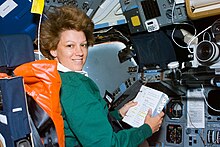
Astronauts perform many tasks as they orbit Earth. The space station is designed to be a permanent orbiting research facility, with a major purpose is to perform science and research that only a space environment can provide. The station crew spends their day working on science experiments that require their input, as well as monitoring those that are controlled from the ground. They also take part in medical experiments to determine how well their bodies are adjusting to living in space for long periods of time.
Working on the space station also means ensuring the maintenance and health of the orbiting platform. Crew members are constantly checking support systems and cleaning filters, updating computer equipment: doing many of the things homeowners must do to ensure their largest investment stays in good shape. Similarly, down on Earth, the mission center constantly monitors the space station and sends messages each day through voice or email with new instructions or plans to assist the crew members in their daily routines.
For those dreaming of working in space, look at the websites of the space agencies to see what they're hiring, and consider what skills might get you into space. Think ahead on how that job market might evolve: they'll probably need fewer pilots but more specialists. Solar panel maintenance, water extraction from Martian shale, who knows?
Buy
[edit]
For most of us stuck down here on Earth, there are a lot of souvenirs at the space centers. Beware though that a lot of them are designed to serve the general public, which can contain science and concepts being represented inaccurately. The best way to buy real souvenirs is to have a good understanding of basic space concepts.
- 1 Kennedy Space Center Space Shop, Kennedy Space Center Visitor Complex, Brevard County, Florida, United States (go east through Florida State Road 528 and turn left at Florida State Road 3), ☏ +1 800 621 9826, SpaceShop@DelawareNorth.com. The shop has a range of products, from T-shirts to space pens. The shop also sell old mission badges, Apollo and Shuttle-themed cups and toys. They also feature unique planet cuddles, which one of them has flown into real space! Products can be bought offline in the shop, or online with shipment from FedEx and USPS.
- SpaceX store, merchandise@spacex.com.. The shop primarily sell wearables, mission patches and Mars-themed souvenirs, in brand with the company's ambitions. They can only be bought online, with support for most major credit cards and Apple Pay.
- Dheespace, ☏ +9513667668, shop@dheespace.com. A shop with ISRO (India space agency) merchandise, such as model rockets, T-shirts, etc.
Eat
[edit]Although space food has come a long way in terms of appeal and variety, the quality and flavor are still not up to standards of most connoisseurs of fine cuisine. Your transportation provider may offer some choice in the foods available, but you will be limited by their willingness to indulge you. Real space food has to be carefully tested to make sure it's nutritionally balanced, can be stored for months without refrigeration, and is suitable for a zero-gravity environment. Food that would leave crumbs, for example, is problematic. The menu on the International Space Station generally consists of American and Russian staples along with other meals and international cuisines that have been requested and developed.
The freeze-dried "astronaut ice cream" sometimes sold on Earth as a novelty item is a misnomer; it has never actually been served on any manned space mission, and the texture is as off-putting to astronauts as it is to everyone else. However, real ice cream has occasionally been eaten in space by astronauts aboard Skylab, the Space Shuttle, and the International Space Station (usually when frozen components for scientific experiments are being sent up and there's some space remaining).
Unfortunately, even with extensive research and development, astronauts find much food in space to be bland and often don't have much of an appetite. In zero-gravity, fluid in your body distributes evenly instead of being pulled to your feet, resulting in a permanent stuffy head that dulls your sense of smell and taste. Space travelers have typically preferred strongly-flavored and spicy foods; beef jerky is a particular favorite. (Similar but weaker phenomena can be observed with airline food, in that case due to the dry low-pressure atmosphere.) Nevertheless, you must eat to maintain energy and body mass. Among many other rules for eating in space, one is key: once you open a package of food, you must eat all of it. Leftover food will rot and become a biohazard, and there's no way to dispose of it until the next resupply mission arrives or you return to Earth.
Standard delicacies
[edit]
Food packaged in Russian cans is generally the best quality-wise but is also the heaviest, so only a limited number of these are allowed. Most food is in plastic pouches; some of these are ready-to-eat after optionally being reheated (a variety of main and side dishes, as well as snacks like granola bars and candies) while many others are dehydrated and must be reconstituted with water (such as borscht, spaghetti with meat sauce, or cereal with powdered milk). Fresh foods like fruit are a treat sent on resupply missions; they must be eaten within two days before they spoil. While most plants grown in space have been for research, astronauts have eaten small amounts of several types of leafy greens that they have grown.
As the fixed menu repeats every 16 days on an extended stay, you'll soon grow tired of the monotony. Astronauts get personal containers in which they can select items not on the fixed menu as well as extras of favorites. Besides standard condiments (liquid salt solution, pepper oil, and ordinary fast-food packets of ketchup, mustard, mayo, etc.), astronauts bring extras like hot sauces, pesto, horseradish, and more. You can also try combining foods to make new dishes; one astronaut wrote, "I cannot think of anything that cannot be put on a tortilla, or has not been put on a tortilla."
- 1 Space Food Systems Laboratory (Space Food Research Facility), Lyndon B. Johnson Space Center, 2101 NASA Parkway, Houston, Texas (At Saturn Lane, turn to 2nd Street, the building is opposite to Delta Link), ☏ +1 281 483 7070. The original NASA space food center. The lab produces freeze-dried food, beverage powders, cookies, candy, and other dried goods. The facility also produces foods in pouches, similar to military's Meals-Ready-to-Eat. Food processing techniques and packaging are based on the item's perishability and ingredient. Space foods are evaluated in a specialized center, where food scientists evaluate the products’ shelf-life and goodness.
- 2 Astrofood (Russian Laboratory of Space Food), 12 Granatnyy St., Presnensky District, Moscow, Russia (From Vspolny Lane, go to Granatny Lane at the left), ☏ +8 995 504 12 12, info@astrofoods.ru. M–F 10:00–19:00. Though not true "space food", Astrofood is a great place if you want tubed food like in the past.
Drink
[edit]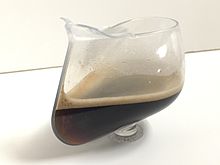
Like space food, space drinks are mainly freeze-dried and packaged in plastic pouches. Coffee, tea, and a variety of fruit drinks are available; they're drunk with a straw, and you have to be careful to always "close" the straw between sips so liquid doesn't get accidentally squirted inside the vehicle. However, recent development has made drinking on an open cup possible, using the wicking effect to flow coffee to the mouth. This requires complex modeling and prior study in space in order to nail the shape right.
Water tends to be scarce (as it is heavy and must be brought from Earth at great expense), so International Space Station machinery recycles water aggressively. Scientific wastewater, humidity, and even urine are all recovered and sanitized. Astronauts don't mind the taste of the recycled water, which is actually purer than drinking water on Earth. And as one astronaut points out, the same kind of recycling happens naturally on Earth, too, just over a much longer timescale. Contrary to popular belief, Tang was invented shortly before the United States space program, although its popularity soared when NASA used it on Mercury and Gemini missions.
Since 2015 the International Space Station has had a machine that can make fresh espresso in addition to other hot drinks. It's used with a special cup that has a narrow spout; surface tension causes water-based liquids to climb the spout, from which you can sip it like you would on Earth. However, in zero-gravity, the crema foam is distributed throughout the espresso instead of floating to the top. Carbonated beverages aren't allowed because the bubbles don't rise in zero-gravity, leading to very unpleasant "wet burps". Alcohol has been consumed on a few flights in the past (mainly by Russian crews), but are prohibited on the International Space Station as it would interfere with the environmental systems, not to mention the potential danger for fire or crew impairment.
Sleep
[edit]
While sleeping in zero gravity may sound relaxing, the overall experience is mediocre. As usual, you're free to choose your pyjamas, provided that they aren't very loose. On the International Space Station, astronauts each have a cabin about the size of a shower stall, so this is definitely not for those with claustrophobia! Inside this, they zip themselves into a sleeping bag on the wall, which can feel weird since you have gotten used to feel a force while laying down. There is no pillows and blanket in space – astronaut Scott Kelly missed the pillow so much that he stick his bag to a cushion.
And it doesn't stop here. Maintaining your circadian rhythm is difficult on a craft that experiences a sunrise and sunset every 90 minutes, and schedule disruptions due to mission planning and long workdays create further problems. Constant noise from the station is annoying, and astronauts are often cold because of the strong ventilation, which is needed to push away the carbon dioxide they exhale and replace it with oxygen. Because of the cosmic rays are streaming through the eyes, you might occasionally see fireworks inside, which would make you missed the sleeping experience on Earth a lot! Some people are a bit luckier, since they sleep inside their spacecraft and do not need to deal with the noises.
- Zvezda module (Russian: Звезда), International Space Station.
- Harmony module, International Space Station.
- Tianhe module, Tiangong space station.
Stay safe
[edit]If you obtain a legitimate ticket to orbit, you will still need to pass through very intensive training and face with a real risk of dying. There are less demanding ways of experiencing space, such as sub-orbital flights and parabolic aircraft flight.
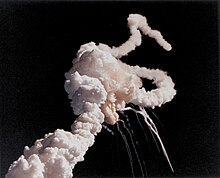
While more mature technology has made it safer than it was in the 1960s, space remains an inherently dangerous environment to put yourself in. Cosmic radiation, extreme temperatures, micrometeorites, engineering mistakes, high speeds, explosive fuels, space debris, the distance to the ground, and the lack of atmosphere make any unplanned situation potentially life-threatening. Spacecraft launch testing is extremely expensive, so spacecraft don't and can't have thousands of flight hours. By the standards of aviation, every space flight is a test flight.
Both launch (our only method of getting to space is to sit on a huge fuel-filled container and hope it behaves like a rocket and not a bomb) and reentry (if you hit it in the wrong angle you burn up in or bounce off the atmosphere) have thus far proven to be the biggest dangers during a mission. So far most accidents have been during launch and reentry as well as during training and testing; only three humans have died in space (albeit during preparations for reentry), but there have been several close calls such as Apollo 13 or the very first spacewalk. Some of the technological problems and close calls only became known to the public decades after they happened, so there may still be dangers you won't even know you're facing.
Voyagers should be wary of purchasing space flights on projects that haven't yet begun. Many ventures are highly speculative; PanAm's “First Moon Flights” Club issued over 93,000 waiting list spots between 1968-1971 and predicted launch dates for many subsequent commercial expeditions have slipped just as dramatically. If there are complications with the project or the company goes under, you might lose your money and your plans. Just look at the bold predictions of some private space companies that have already proven to be less permanent than a shooting star.
Don't even attempt to commit anything that could be interpreted as a crime in space, as the law around space crime is fuzzy and undeveloped. There has been at least one instance that an International Space Station astronaut got involved in legal trouble, causing headaches to lawyers and such. Usually, the suspect would generally be tried by the nation they're a citizen of.
Stay healthy
[edit]
Astronaut training is physically demanding, so good physical fitness is a good starting point. Similar physical and mental stresses are present in particularly demanding types of military service, piloting fighter aircraft, mountain climbing, Antarctic expeditions, and advanced scuba diving such as cave diving. National astronaut programs often require athlete-like physical fitness and experience from these or comparable tasks. There are no hospitals in space and rescue is difficult or impossible, so people with conditions that might require immediate medical treatment are not qualified for space travel.
Although early astronauts hid the truth to protect their tough-guy image, we now know that about half of all travelers experience space sickness, a condition related to motion sickness with similar symptoms including vomiting and vertigo. Most people adapt within 3 days, and medicinal anti-nausea patches help with the symptoms.
You need to exercise to stay healthy in zero gravity. Even so, you'll still lose both bone and muscle mass. Astronauts on extended stays are required to exercise at least 2.5 hours every single day. While exercise helps diminish the problem somewhat, a long stay will still see you weakened, and several cosmonauts and astronauts had difficulty getting out of their capsule and onto their own feet upon landing.
Another concern is cosmic radiation. While you're exposed to a certain level of background radiation at all times, it gets higher in certain areas on earth and once you leave the protective layers of the atmosphere. This is already notable on a commercial transatlantic flight at 10,000 m, and only gets worse if you go up to the International Space Station at 400 km above the Earth's surface. While the International Space Station still enjoys some limited protection against radiation, once you go well beyond that height, or even to the moon, there are short term and long term risks associated with radiation that only get worse the longer you stay. Particularly dangerous are solar storms that may give you a year's worth of radiation in just a couple of hours. Shielding against radiation is also one of the major problems in ever sending humans to Mars, as all known solutions involve huge amounts of extra weight for the spacecraft or too high a risk to the crew.
Connect
[edit]
In the past, communications are usually very low bandwidth, with flight data and audio transmitted by low-gain antennas. Higher data rate is now available, thankfully, and now astronauts can stream movies in space. A very common activity of astronauts in the International Space Station is to talk with their relatives at homes, as this would boost their morale. Keep in mind that the data speed can be very variable depending on priorities and time of the day, so usually communications from Earth to space can be poorer than the usual high-bandwidth cellular and WiFi. In the near future, satellite constellations like Starlink may provide gigabit speed to the spacecraft, via laser communications. It is possible to send small objects like physical mails and souvenirs between International Space Station expeditions, though you must have black hole-deep pocket to afford such long trips.
An astronaut has been able to dial 911 from the International Space Station, but this is not recommended as they probably cannot help you. Instead, refer to your instructions by the contractor when there is an emergency. You should never try to fix a problem alone in space – there are an army of people on the ground that will instruct on what to do. Though, if there is such the need there is an official listing of radio frequencies to contact people from the ground using Kenwood D710E and Kenwood D710GA radios. Call sign is either RS0ISS for Russian; NA1SS for American; DP0ISS, OR4ISS, IR0ISS for European; and RS0ISS-11, RS0ISS-1 for packets.
- 145.80 MHz: voice and slow scan television (SSTV)
- 145.825 MHz: packet communications in the very high frequency range
- 437.550 MHz: packet communications in the ultra high frequency range
- 437.80 MHz: repeater
For the opposite, it is possible to communicate to the International Space Station, but some events require prior applications.
- 144.49 MHz: voice for the Americas, and the Pacific and Southern Asia (ITU Regions 2 and 3)
- 145.20 MHz: voice for the Europe, Russia and Africa (ITU Regions 1)
- 145.825 MHz: packet communications in the very high frequency range
- 437.550 MHz: packet communications in the ultra high frequency range
- 145.99 MHz and 67 Hz squelch tone (PL): repeater
Cope
[edit]Electricity
[edit]Electrical systems in space are vastly different compared to Earth. This is because space stations are international projects, which need to reach a compromise for all countries involved. On the International Space Station, electricity is provided by solar panels and batteries, distributed across many plugs designed by various standards. Roughly speaking, the United States side uses 120V DC, and the Russia side uses 28V DC, so don't plug in normal equipment directly, even with an adapter. Instead, use an inverter box provided on the station. However, most equipment are hardwired to the power system and don't use plugs. For you, space tourists, you should contact your contractors or government employers for further information.
Hygiene
[edit]
Some toilets in space come in different shapes, but they usually operate on similar principles. They generally have a funnel-like receptacle for urine and a larger bowl for solid waste, both using suction to capture the material and any odors. You have to hold on or strap in, of course, and there are procedures to follow for operating the toilet and cleaning up afterwards. The degree of privacy depends on the craft; stations have enclosed cabins as did the Space Shuttle, but in smaller craft it may be merely tucked away in a corner, hidden behind a curtain, or is in the open and you have to ask your fellow passengers to face the other way. On short missions, many astronauts prefer to simply avoid using the toilet, relying on enemas before launch and low-fiber diets.
Clothes in space actually don't get dirty very quickly, due to a variety of environmental factors. Wearing the same underwear 3-4 days in a row is no big deal! However, there's no practical way to wash clothes in space; astronauts get fresh clothes from resupply missions, and the dirty ones are either incinerated by sending it into Earth's atmosphere, or recovered during the trip back home.
Although a shower was tested on Skylab with mixed feedback from astronauts, it was large and cumbersome, and hasn't been used again. Astronauts take sponge baths using liquid soap, water, and shampoo provided in bags. Washing of hands and cutlery is similarly done with napkins and washcloths. Brushing your teeth in space is very similar to back on Earth. However, after you're done, you must swallow the paste because there is no water sinks. An alternative method is neatly spit the paste onto a disposable tissue, which will get burnt in the atmosphere as trash.
News and entertainment
[edit]Mental health in space is paramount. You're stuck with a small number of people in very cramped quarters for weeks at a time, or months for permanent crew on the International Space Station. While short missions may be different, astronauts on the International Space Station do get weekends and a few holidays off. They have a projector for watching select TV shows and movies (sometimes before they play in theaters), and laptops for surfing the internet and talking to family. They bring their favorite hobbies with them, and the International Space Station now has an assortment of musical instruments on board.
Religious services
[edit]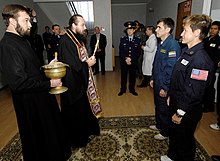
Although sticking to the traditional rituals and schedules can be difficult, religion has been actively practiced in space:
- Christians have celebrated Communion in space, including Buzz Aldrin from the surface of the Moon during Apollo 11 and several astronauts on the International Space Station. Christmas is celebrated every year on the International Space Station, which includes a small artificial Christmas tree, Christmas dinner, and sometimes presents for the crew. Sometimes, Christmas is celebrated more than once, due to differences between the Julian calendar used by the Russian Orthodox Church and the Gregorian calendar.
- Islam has been practiced in space and there are guidelines for how to pray in space, which address kneeling, facing Mecca, and washing. The religion also instruct how to time prayers and fasts for a 24-hour day when experiencing a sunrise and sunset every 90 minutes, which also generally based on the point of departure from land. It may be difficult or impossible to verify whether food is halal, in which case one should eat just enough to ward off hunger. There is a fatwa forbidding devout Muslims from participating in one-way missions to Mars, as the risk to life is considered too great.
- Judaism has also been practiced in space, and there are similar guidelines for observing Shabbat, based on the point of departure from land, and orienting oneself while praying. Some adaptations may be needed to affix a mezuzah or wear a prayer shawl. Keeping kosher is possible with appropriate selection of meals, and there is already personal time allocated in schedules which could be used to study the Torah. However, properly observing tzniut (modesty) in mixed-gender crews might be impossible as that would require separate showers and toilets for men and women, which no vessel has. The danger to one's life should also be weighed carefully.
No matter your religion, if in doubt of the rules, check with an appropriate religious authority. If possible, do so several months or years in advance so leaders have enough time to consider the implications and determine the answers.
Go next
[edit]
What goes up must come down—at least for now. Once you've exhausted the Moon, there are countless opportunities for exploration and discovery down on Earth.


